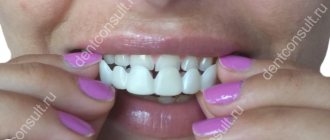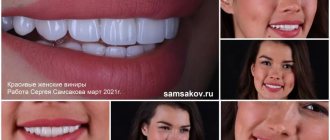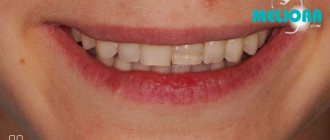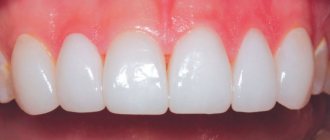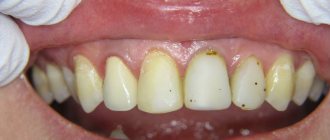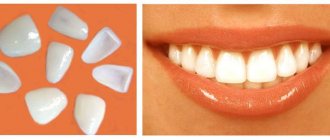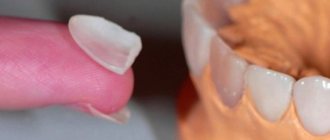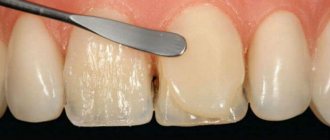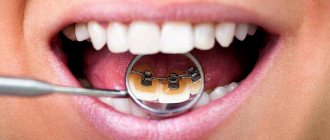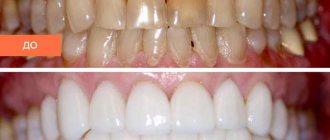What are composite veneers and their composition
Composite (direct) veneers are special overlays on the front surface of the teeth, which are made from composite materials in the patient’s mouth. The reflective material is applied in layers directly to the surface of the teeth. One visit to the dentist is enough to complete the procedure.
A composite is a spatial three-dimensional combination of two or more chemical substances, in which there is a clear interface - it can be seen even with the naked eye. This combination enhances the properties of each component several times.
The first composite materials entered the dental market in 1964, but since then they have evolved, becoming more convenient and safer for humans, because during this period:
- new adhesives were created;
- the color scheme was improved;
- the strength of materials increased.
The main components of a modern composite:
- polymer matrix consisting of:
- polymerization inhibitor, which increases the shelf life of the substance;
- main and additional catalyst;
- activator;
- an ultraviolet absorber that prevents the color of the linings from changing when exposed to sunlight;
- inorganic filler, thanks to which:
- the aesthetic properties of microprostheses are increased, since the mineral filler has physical characteristics close to natural teeth;
- material deformation is prevented;
- the hardness and resistance of the composite increases;
- Surfactants or silanes are organosilicon compounds that increase the strength of the material.
Of these three components, the properties and differentiation of the composite are most influenced by fillers, which are classified based on the following characteristics:
- according to the material:
- from quartz;
- from silicon dioxide;
- from diamond dust;
- made of barium glass;
- According to the size of filler particles, there are composites from 0.04 to 45 microns;
- by particle shape:
- sticks;
- antennae;
- spirals;
- shavings;
- dust;
- ground.
Most dental composites used to make veneers are primarily composed of ground barium glass particles, but much depends on the manufacturer.
Ceramic veneers
“Ceramics” is a broad concept that includes a wide variety of materials. Their main feature is the absence of metals. Therefore, ceramic products are suitable for patients with metal allergies. Ceramic veneers are divided according to the following criteria:
Chemical composition
- Polycrystalline
- Feldspar based
- Glass ceramic
Manufacturing method
- Layer-by-layer application
- Hot pressing
- Computer modeling followed by milling (CAD/CAM)
Zirconium onlays consist of a zirconium dioxide frame and ceramic layers applied in layers.
Classification of composite onlays for teeth
Composite veneers are classified based on the number and size of particles they contain. According to this criterion, composite linings are divided into:
- cheap veneers with large composite particles (more than 30 microns): they quickly fade and cannot be further processed;
- overlays with mini-filler and particles up to 1.5 microns;
- hybrid composite veneers with particles measuring about 1 micron;
- microprostheses with microparticles (up to 0.04 microns), used exclusively to restore the aesthetic appearance of the front teeth.
Flaws
- Composite materials used for direct veneering require periodic correction and polishing, as they quickly fade and wear out.
- Increased abrasion of linings.
- The increased fragility of veneer plates increases the risk of structural failure.
- Swelling of the composite material in a humid environment often causes hyingivitis, bleeding gums, irritation, depressurization of the edges of the lining, pigmentation of the border, and complicates oral hygiene.
All of the above shortcomings lead to a loss of aesthetics and require replacement of the restoration.
The service life of direct veneers, with sufficient care and compliance with functional load standards, ranges from three to 8-9 years.
Indications for installation
Veneers made of composite material perfectly mask the following dental defects:
- abnormal shape of teeth;
- dental chips;
- wide spaces between teeth;
- uneven contours of the front teeth;
- displacement of crowns in the vertical plane;
- yellow or gray spots on the enamel that cannot be bleached;
- age-related change in enamel shade;
- thinning teeth;
- defect of the filling material: change in color of the filling, slight chipping;
- increased wear of crowns.
The installation of veneers is indicated if it is necessary to visually correct the condition of several teeth in the smile area. But in case of significant defects, it is more advisable to use other dental methods for correcting the dentition.
Veneers without grinding
The high level of professionalism of our clinic’s specialists makes it possible to carry out the most effective methods of dental restoration - if necessary, both classic veneers and veneers without grinding can be installed. This is determined not only by the desire and financial capabilities of the client, but also by a number of objective indications, because veneers without grinding can not be installed in all cases - in some situations they may not be necessary at all.
Although it should be noted that veneers without turning have a number of important advantages and are successfully used in many cases:
- Correction of the color and shape of teeth, as well as normalization of their length or correction of the tooth margin.
- Adding volume to the outer tooth surface.
- Aligning a tooth that is positioned incorrectly is done to eliminate the visual effect.
- Masking significant gaps between adjacent teeth (they are called diastemas, tremas)
- Restoring the shape of a tooth after a mechanical injury - with a chip or crack.
- Elimination of wedge-shaped tooth defects.
An important point regarding teeth grinding is that it may not be carried out if live broadcasts are installed. Indirect veneers are also installed without preparing the entire outer tooth surface.
The most successful examples when specialists at our clinic used veneers without grinding teeth:
- When adjusting the shape of teeth, provided that there are no defects on the dental surfaces in the form of caries and other dental pathologies. If there are signs of carious lesions, there is definitely a need to eliminate it, because otherwise, if everything is left as is, destruction of the tooth under the veneer will occur, which will be accompanied by a change in color. It is logical to assume that this phenomenon will not go unnoticed - it will become visible through the veneer, thereby significantly worsening the aesthetics.
- If necessary, leave the enamel intact. In principle, you can do this, and even better. And it should be clearly understood that the composite material will be quite securely fixed to the tooth.
- In order to add volume to the outer surface, which makes it possible to greatly change the shape of the dental crown.
- In cases where the patient has significant tooth wear. In this case, in order to install veneers and raise the lower third of the face, the height of the bite is raised through the use of ceramic crowns.
- If it is necessary to improve the condition of the cutting surfaces of the front teeth, this contributes to a better perception of the correct position of the teeth. Veneers without grinding create the visual impression that the teeth have been straightened, although this work has not been done.
- When veneers are made without grinding the teeth, the side surfaces remain slightly rough - this can significantly improve adhesion, which in turn increases the reliability of operation. Quality is achieved through the use of a special polishing disc.
- There is another important advantage of this technique - veneers installed without grinding the teeth do not require anesthesia, since no dental processing is required. But in some situations the need for it still arises - as an option, if the use of threads and matrices is necessary.
- Please note that our clinic’s specialists have extensive experience in installing veneers without grinding teeth, even in the most complex and unusual situations. Please note that the determination of the method of installing veneers is carried out only by the attending physician. When installing direct composite veneers, the doctor takes on a kind of increased responsibility for the result, because even the most minor defect can cause the need to redo the work.
It is important
The question of which veneers to use (composite or ceramic) is relevant in this case cannot be resolved by the patient or his relatives! Do not try to make a diagnosis yourself and choose the appropriate method for restoring a beautiful smile using various websites - only a doctor can do this, establishing the presence of indications and contraindications, as well as performing basic research in the laboratory. Everything will depend on this - both the execution technique and the material (indirect, direct composite or ceramic). Each technique has its advantages and disadvantages, and if in some cases one is used and not another, this does not mean that one is worse and another is better.
Contraindications for installation
Direct veneering is contraindicated in the following cases:
- insufficient oral hygiene, as there is a high risk of developing caries directly under the linings;
- the presence of carious cavities;
- malocclusion and the need to wear braces;
- the presence of inflammatory processes in the mouth;
- bruxism;
- tooth mobility;
- erupting wisdom tooth;
- the presence of pulpless dental units, as they are more prone to destruction;
- serious enamel defects.
If the listed pathologies are eliminated, anyone can get direct composite veneers, and they will last for quite a long time.
Contraindications
Based on the above disadvantages, you can assess the risk of installing veneers from a light-curing composite and make a list of obvious contraindications for which it is better to use ceramics or even choose a crown as an alternative restoration option.
- If you have a reverse or direct bite, installing onlays on your teeth is extremely undesirable;
- A tendency to bad habits that damage teeth will quickly render the composite unusable (after installation, you should not chew seeds, pencils, nuts, nails, open bags and bottle caps with your teeth, etc.);
- It is useless for athletes involved in dangerous sports to use pads, since they will be broken at the first strong blow;
- With bruxism or pathological abrasion of enamel, composite veneers will not help for a long time;
- It is not recommended to use onlays to restore severely damaged, weakened, crooked, or very short teeth;
- Before installing a composite, it is imperative to cure caries, since otherwise it will continue to destroy the tooth under the onlay. The same applies to sore gums.
Before deciding to have composite onlays installed, be sure to consult with your regular healthcare provider. He may recommend some other treatment option for you.
Advantages and disadvantages of veneering
The main advantages of composite veneers include:
- speed of production and installation: you don’t even need to make additional impressions;
- durability subject to proper use and quality care;
- beautiful appearance;
- maximum naturalness: modern composite materials transmit light well.
But composite veneers also have disadvantages:
- relative fragility, which manifests itself if a person does not take care of the pads and does not use suitable personal hygiene products;
- slight masking ability, which manifests itself in the presence of teeth that are too dark in color or bright, prominent spots (due to tetracycline);
- the need to grind down the enamel: after removing the veneers, the teeth need to be restored.
If only the central and lateral incisors are restored using veneering, then the remaining teeth often have to be whitened.
The quality of installation of veneer microprostheses depends on the skill of the dentist. Not all dentists can beautifully install veneers, so before installing them, it is recommended to check with the doctor about his track record and ask for photos of the work he has performed.
You should also pay attention to the cost of veneers, since professionals do not work at minimum prices. The approximate average cost of one direct composite veneer in Moscow and St. Petersburg is 8–9 thousand rubles. for one tooth . Minimum prices for composite veneers start from 4 thousand 500 rubles. Veneering is not covered by compulsory medical insurance, as it is a cosmetic procedure.
Advantages and disadvantages
pros
Composite overlays are characterized by the following advantages:
- economical (three times cheaper than ceramic);
- minimal time investment (onlays created by the direct method are installed in one visit to the doctor, unlike ceramic veneers and crowns).
In addition, the installation of composite veneers is technologically compatible with the treatment of caries. That is, fixing the lining can occur together with filling carious cavities.
Another important positive aspect is gentle (and in some cases even zero) tooth preparation. By comparison, more dental tissue is ground down for a crown.
Stages of manufacturing direct composite veneers
It is better to do dental overlays in the first half of the day, when it is light and sunny. This will help the dentist correctly select the shade of the material. Direct veneers are made in the patient's mouth. The whole procedure consists of several stages:
- Visual inspection and sanitation of the oral cavity. A few days before the procedure, you can undergo a professional teeth cleaning session.
- Choosing the shade of veneers according to the Vita scale. The most responsible approach to choosing the color of the composite material is if you need to place literally 1-2 veneers and you want these veneers to be no different from the rest of the dentition.
- Hardware grinding of the teeth to which the composite material will be applied.
- Applying layers of composite material to the front surface of the teeth. Typically, 7 layers of material are required to achieve maximum strength of a microprosthesis.
- Turning and grinding of veneers.
Price for direct veneers
When comparing direct and indirect veneers, the former are much cheaper for two reasons:
- There is no laboratory stage in their production, i.e. no dental technician is involved in the process;
- photopolymer material is cheaper than ceramic mass;
- modeling takes one, maximum two visits (if the entire dentition is covered at once).
The price for direct veneers in Kiev starts from 1800 UAH per unit and in some clinics reaches 6 thousand UAH or more. In other cities of Ukraine, the price of direct composite veneers is slightly lower – 1200-3300 UAH.
In St. Petersburg and Moscow, composite veneers made using the direct method will cost at least 5-7 thousand rubles. for one tooth . It is worth considering that this price does not include preparatory procedures, such as cleaning.
Thus, this type of veneer is the most affordable of those that dentists can offer. And although the quality of direct overlays is not the highest, not everyone can afford to install a Hollywood veneer at a price of 40 thousand rubles. Therefore, direct dental restoration remains among the top most popular dental procedures.
Product service life
Manufacturers of veneers claim that microprostheses can last in the mouth for about 5–6 years, but in fact it is better to focus on a period of 3–4 years. Moreover, the veneer will lose its whiteness and shine approximately a year after installation, which is due to the large amount of dyes consumed in food and a violation of the acid-base balance in the oral cavity.
Changing the color of veneers is facilitated by:
- red wine;
- spices like curry;
- coffee;
- strong tea;
- colored carbonated drinks.
After veneering, it is recommended to avoid coloring products or reduce their consumption to a minimum. If a person smokes, then it is better for him to install ceramic veneers rather than composite ones. Composites are easily stained from exposure to cigarette smoke.
Installation process
- Hygienic tooth cleaning. The vestibular and lingual surfaces are cleaned with a circular nylon brush and fluoride-free polishing paste.
- Definition of color. Using the standard Vita scale, the color of the composite material is selected. There are shades of opaque, enamel, incisal edge, tooth neck and whitened teeth.
- Preparation of carious cavities:
- Hard tissue affected by caries is removed. A gentle technology is used, the purpose of which is to preserve healthy tooth tissue as much as possible;
- removal of remnants of previously carried out restorations;
Determining the color of the future veneer
Result:
- the veneer should not protrude beyond the level of neighboring teeth;
- the cutting edge should not be depleted;
- there should be no leakage of material into the gingival sulcus;
- The completed restoration should have a dry shine.
The thickness of a direct veneer should be at least 1 mm. If the tooth is heavily depulped or has a greatly discolored tooth, then the thickness increases.
IMPORTANT! When choosing the color of the veneer, the tooth surface must be moistened. Overdried enamel changes color, which results in incorrect color selection during restoration.
After the procedure at the dentist, you should refrain from eating for two hours. During the day, you should not eat solid food or consume coloring foods: tea, coffee, berries, etc. Smoking and women are not allowed to wear bright lipstick.
Componeer direct composite veneers
Componers are used to improve the color of the surface of teeth and to restore their shape. They are ready-made enamel overlays. Installation of compositors is faster and easier due to the fact that the period of preparation of the oral cavity for restoration is reduced.
Componers cannot be installed if:
- occlusion;
- periodontal pathologies;
- parafunction of masticatory muscles;
- significant tooth decay.
There is no grinding when installing composites, which preserves the appearance and health of the treated teeth. If microprostheses need to be removed in the future, no additional enamel restoration will be required.
Making a veneer
The prosthesis is manufactured in several stages, including:
- Selection of the required color (occurs on the tooth before preparation, when the tooth is naturally moistened).
- Making an impression of the tooth (necessary for a temporary prosthesis; made using alginate masses).
- Preparation (mechanical influence on the tooth, performed using a bur).
- Selecting the shade of the stump (the stump should match the shade of the onlay).
- Taking an impression and establishing occlusion (if the plate is installed indirectly, the specialist takes a working impression of the tooth and conducts a thorough examination of the condition of the tooth).
- Development or fastening of a temporary prosthesis (the veneer itself is modeled based on the impression; strong adhesive materials are not used during fastening, since the temporary plate requires its subsequent removal).
- Careful fitting of the veneer (at this stage the product is checked for compliance with important characteristics: shape, color, marginal fit; the result must be approved by the patient).
- Fixation (the veneer is secured using composite cements; fixation occurs adhesively).
Photos before and after installing veneers using the direct method
Teeth before and after installation of veneers
Teeth affected by fluorosis before and after veneering
Installing direct composite veneers is a relatively inexpensive way to make your smile beautiful and snow-white. This procedure is carried out for many pathologies, but the durability and naturalness of microprostheses depend on the professionalism of the dentist and the equipment of the dental clinic.
What to choose: veneer, crown or braces
If there are no contraindications to installing veneers, it is better to give them preference. The main difference between the devices is that the use of a crown requires grinding of the tooth, which after such processing becomes like a “stump”. Sometimes it is necessary to remove the nerve. Installing a veneer involves removing the top layer of enamel on the front wall near the cutting edge.
Patients often choose between veneers and braces, not knowing which to choose. In fact, it all depends on how crooked the teeth are. Veneers only mask the defect and do not correct it. This method justifies itself only when the result is needed urgently or it is simply necessary to hide a defect.
Veneers can correct the bite only in cases of minor pathology. Doctors usually advise correcting the bite without grinding the enamel using braces.
What is the difference between composite veneers and ceramic veneers?
Ceramic plates are among the most advanced restorative materials used in dental practice. Their production is carried out exclusively in laboratory conditions after creating impressions of the teeth to be restored. As a rule, classic ceramic veneers have a thickness of 0.5-0.7 mm, and ultra-thin overlays made from pressed ceramic mass are about 0.3 mm.
In order to firmly fix such products on the teeth, a special adhesive composition is used. If you are interested in how composite veneers differ from ceramic ones , then first of all you should note the aesthetic perfection of the latter. This is due to the fact that ceramics uniquely replicates the optical parameters and structure of natural enamel.
Moreover, during the production of ceramic plates there are almost no chips, they are resistant to dyes and never lose their original shade. Also, if they are installed, the need for periodic visits to the doctor for the purpose of polishing such products is eliminated. Also, the service life of ultra-thin overlays can reach 20 years, which also distinguishes composite and ceramic veneers.
The negative aspects that characterize such ceramic veneers include an impressive price and non-repairability. Despite the considerable strength of such plates, if they are not used carefully, there is a possibility of chipping, but it is no longer possible to restore them.
Which veneers are better: composite or ceramic?
Previously, we looked at how composite veneers differ from ceramic ones. Now let’s try to figure out which plate option is still the winning one. To give a clear answer to this question, you should pay attention to the following nuances:
- Despite the impeccable aesthetics of ceramic products, an experienced specialist is able to achieve an ideal result even when installing a composite veneer on a crooked tooth . In this case, a correct understanding of the clinical picture is key;
- In some cases, it is enough for the patient to undergo professional whitening, which will significantly improve the shade of natural teeth;
- It should be remembered that composite veneers are fixed in Moscow clinics only for minor interdental spaces or a non-critical need to change the shape of the tooth. If there is significant curvature of the teeth, massive “gaps” between the teeth or excessive abrasion, it is better to focus on ceramic plates;
- As you know, composite veneers have a more affordable price per tooth and can be fixed in one visit to a specialist. However, in the future you will need to regularly visit the dentist for additional polishing. Moreover, their operational period reaches only 4-5 years, which explains the need for periodic updating;
- Despite the fact that composite veneers have a more reasonable price in Moscow, it is better to opt for ceramic analogues. This is due to the increased strength and long service life of the latter.
Read more about the best e.max glass-ceramic veneers »
